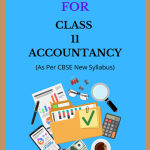NCERT Class 11 Accountancy MCQ Chapter 7 Depreciation, Provisions and Reserves Solutions, AHSEC Class 11 Accountancy Multiple Choice Question Answer to each chapter is provided in the list so that you can easily browse throughout different chapters NCERT Class 11 Accountancy MCQ Chapter 7 Depreciation, Provisions and Reserves Question Answer and select needs one.
NCERT Class 11 Accountancy MCQ Chapter 7 Depreciation, Provisions and Reserves
Also, you can read the SCERT book online in these sections NCERT Class 11 Accountancy Multiple Choice Solutions by Expert Teachers as per SCERT (CBSE) Book guidelines. AHSEC Class 11 Accountancy MCQ Solutions. These solutions are part of SCERT All Subject Solutions. Here we have given HS 1st Year Accountancy Objective Type Question Answer for All Subjects, You can practice these here.
Depreciation, Provisions and Reserves
Chapter: 7
| PART – Ⅰ |
MULTIPLE CHOICE QUESTION ANSWER
1. What is the primary definition of depreciation according to AS-6 (Revised)?
(i) A measure of profit earned from asset usage.
(ii) A measure of the wearing out, consumption, or other loss of value of a depreciable asset.
(iii) A measure of increase in asset value.
(iv) A one-time expense for an asset.
Ans: (ii) A measure of the wearing out, consumption, or other loss of value of a depreciable asset.
2. In the example given, if a machine’s cost is Rs.1,00,000 and the annual depreciation is Rs.10,000, how much will be charged to the income statement for depreciation in the first year?
(i) Rs. 1,00,000
(ii) Rs. 10,000
(iii) Rs. 90,000
(iv) Rs. 0
Ans: (ii) Rs. 10,000
3. If a machine is purchased for Rs.1,00,000 and has a useful life of 10 years, what would be the annual depreciation expense?
(i) Rs.5,000
(ii) Rs.10,000
(iii) Rs.20,000
(iv) Rs.50,000
Ans: (ii) Rs.10,000
4. How is depreciation best described?
(i) A temporary increase in the value of fixed assets.
(ii) A permanent, continuing, and gradual shrinkage in the book value of fixed assets.
(iii) A measure of profits earned from asset usage.
(iv) An expense incurred only when an asset is sold.
Ans: (ii) A permanent, continuing, and gradual shrinkage in the book value of fixed assets.
5. What is the primary significance of depreciation in an enterprise?
(i) It determines the selling price of assets.
(ii) It has a significant effect in determining and presenting the financial position and results of operations.
(iii) It solely affects cash flow statements.
(iv) It is only relevant at the time of asset disposal.
Ans: (ii) It has a significant effect in determining and presenting the financial position and results of operations.
6. Which of the following is NOT considered a depreciable asset?
(i) Machinery.
(ii) Land.
(iii) Furniture.
(iv) Vehicles.
Ans: (ii) Land.
7. A company purchases a machine for Rs.50,000. It has an estimated useful life of 5 years and a salvage value of Rs.5,000. What is the annual depreciation using the straight-line method?
(i) Rs.9,000
(ii) Rs.10,000
(iii) Rs.11,000
(iv) Rs.12,000
Ans: (ii) Rs.10,000
8. Dividend Equalization Reserve And Debenture Redemption reserve are examples of______
(i) Revenue Reserve.
(ii) General Reserve.
(iii) Capital Reserve.
(iv) Secret Reserve.
Ans: (i) Revenue Reserve.
9. The piece of equipment costs Rs.100,000 and has a useful life of 10 years with no salvage value. If the company uses the double declining balance method, what will be the depreciation expense for the second year?
(i) Rs. 20,000
(ii) Rs. 40,000
(iii) Rs. 18,000
(iv) Rs. 36,000
Ans: (iv) Rs. 36,000
10. A business decides to sell a machine after 4 years of use. The machine was purchased for Rs.80,000 with an estimated useful life of 10 years and a salvage value of Rs. 8,000. If it is sold for Rs.50,000, what is the gain or loss on the sale?
(i) Gain of Rs. 10,000.
(ii) Loss of Rs. 2,000.
(iii) Gain of Rs. 2,000.
(iv) Loss of Rs. 10,000.
Ans: (iii) Gain of Rs. 2,000.
11. Given a profit before depreciation and tax of Rs.50,000 and a depreciation expense of Rs.10,000, what is the profit before tax?
(i) Rs.60,000
(ii) Rs.50,000
(iii) Rs.40,000
(iv) Rs.30,000
Ans: (iii) Rs.40,000
12. According to Companies Act, creation of secret reserve is prohibited except in case of______
(i) Banking, Insurance and Financial companies.
(ii) Commercial undertakings.
(iii) Industrial undertakings.
(iv) NGOs.
Ans: (i) Banking, Insurance and Financial companies.
13. If a company buys a patent for Rs.10,00,000 with a useful life of 10 years, the annual amortisation expense would be:
(i) Rs.1,00,000
(ii) Rs.10,00,000
(iii) Rs.5,00,000
(iv) Rs.50,000
Ans: (i) Rs.1,00,000
14. According to which Accounting Standard, companies are liable to make provision for depreciation?
(i) AS-6 (Revised).
(ii) AS-4 (Revised).
(iii) AS-3 (Revised).
(iv) AS-10.
Ans: (i) AS-6 (Revised).
15. A franchise with a cost of ₹6,00,000 and a useful life of 12 years would have an annual amortisation expense of:
(i) Rs.6,00,000
(ii) Rs.50,000
(iii) Rs.5,00,000
(iv) Rs.1,00,000
Ans: (ii) Rs.50,000

Hi! my Name is Parimal Roy. I have completed my Bachelor’s degree in Philosophy (B.A.) from Silapathar General College. Currently, I am working as an HR Manager at Dev Library. It is a website that provides study materials for students from Class 3 to 12, including SCERT and NCERT notes. It also offers resources for BA, B.Com, B.Sc, and Computer Science, along with postgraduate notes. Besides study materials, the website has novels, eBooks, health and finance articles, biographies, quotes, and more.




